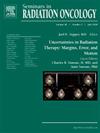辩论2:前列腺癌局灶外束放射治疗强化优于近距离放射治疗强化的案例
IF 3.2
3区 医学
Q3 ONCOLOGY
引用次数: 0
摘要
现代试验表明,用放射疗法治疗局限性前列腺癌的效果很好。然而,一些患者会出现复发,超过三分之一的复发局限于前列腺。通过剂量强化来强化治疗可以使一些局限性、不良风险前列腺癌患者获益。目前,现代3期随机对照试验支持两种治疗策略。ASCENDE-RT评估了全腺体LDR近距离治疗的增强效果,FLAME评估了局灶外束放疗(EBRT)对mri可见病变的增强效果。本综述比较了flame型EBRT增强与LDR近距离治疗增强在肿瘤预后、毒性和可行性方面的差异。FLAME试验表明,EBRT对MRI可见病变的增强可以改善局部控制以及区域和远处转移的生存,而不会显著增加毒性。相比之下,ASCENDE-RT仅改善了生化无复发生存,而这是以增加胃肠道和泌尿生殖系统毒性为代价的。除了疗效和毒性之外,我们还讨论了每种技术广泛实施的挑战,因为治疗进步只有在它们可用时才有益。虽然这两种技术在实施方面都有独特的障碍,但我们认为解决重点EBRT促进实施的障碍是更容易解决的。总之,我们认为现有的高水平证据支持局灶性EBRT增强优于近距离治疗,因为局灶性EBRT增强已被证明在对生活质量影响最小的情况下对肿瘤预后有显著改善。本文章由计算机程序翻译,如有差异,请以英文原文为准。
Debate 2: The Case for Focal External Beam Radiation Therapy Boost Over Brachytherapy Boost for Prostate Cancer
Modern trials demonstrate excellent outcomes for men with localized prostate cancer treated with radiation therapy. However, some patients experience recurrences, and more than one-third of recurrences are localized to the prostate. Treatment intensification through dose intensification could substantially benefit some patients with localized, unfavorable-risk prostate cancer. Currently, modern phase 3 randomized controlled trials support 2 treatment strategies. ASCENDE-RT evaluated whole-gland LDR brachytherapy boost, and FLAME evaluated a focal external beam radiation therapy (EBRT) boost to MRI-visible lesions. This review compares a FLAME-style EBRT boost vs a LDR brachytherapy boost in terms of oncologic outcomes, toxicity, and feasibility. The FLAME trial demonstrates that an EBRT boost to MRI visible lesions improves local control as well as regional and distant metastasis free survival without a significant increase in toxicity. In contrast, ASCENDE-RT reports an improvement in only biochemical recurrence free survival, and this comes at the expense of increased gastrointestinal and genitourinary toxicity. Beyond efficacy and toxicity, we discuss the challenges to widespread implementation of each technique, as treatment advances are only beneficial if they are available. While both techniques have unique barriers to implementation, we believe addressing the barriers for focal EBRT boost implementation are more addressable. In conclusion, we maintain that available high-level evidence supports a focal EBRT boost over brachytherapy because focal EBRT boost was shown to give a meaningful improvement in oncologic outcomes with minimal impact on quality of life.
求助全文
通过发布文献求助,成功后即可免费获取论文全文。
去求助
来源期刊
CiteScore
5.80
自引率
0.00%
发文量
48
审稿时长
>12 weeks
期刊介绍:
Each issue of Seminars in Radiation Oncology is compiled by a guest editor to address a specific topic in the specialty, presenting definitive information on areas of rapid change and development. A significant number of articles report new scientific information. Topics covered include tumor biology, diagnosis, medical and surgical management of the patient, and new technologies.

 求助内容:
求助内容: 应助结果提醒方式:
应助结果提醒方式:


